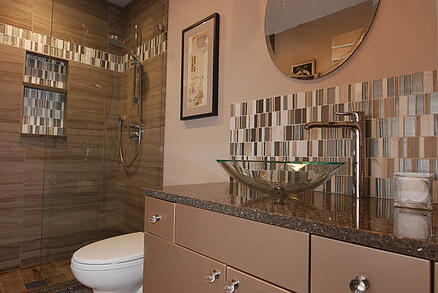 Vessel sinks make a definitive statement in a Chicago bathroom remodel because - in addition to a more physical, vertical visual on the countertop – there are so many styles and “personalities” to choose from.
Vessel sinks make a definitive statement in a Chicago bathroom remodel because - in addition to a more physical, vertical visual on the countertop – there are so many styles and “personalities” to choose from.
Vessel sinks entered the design scene as edgy rebels, back in the early 2000s. Bold homeowners installed them, and designers typically fell into two camps- those who loved them and those who didn’t. Nobody was really sure whether vessel sinks were more of a fad or a bathroom trend that would stick around.
Nearly two decades later, vessel sinks have stood the test of time, and are a design standard of a sort. There are pros and cons to choosing vessel sinks over more standard sink options, so it’s worth running through the comparisons before makin a final decision.
Pros of Vessel Sinks
Style galore
Since vessel sinks rest directly on the countertop, they're like a 3-D addition to a bathroom design. They add style galore – and you can vamp that up all you want, depending on the type of sink you select. Also, because the sink is stylish – so too should the bathroom sink faucet be stylish – opening up creative faucet options.
One-installation wonder
With the vessel sink serving as a feature, you get a lot of design punch in a single feature. This can be especially helpful in small bathrooms – like powder rooms – where too much style elsewhere may crowd the space and/or feel overwhelming.
No specific sink hole requirements
Standard sinks are cut into the countertop, requiring very specific hole cut-outs, based on the sink manufacturer’s specifications. With a vessel sink – the only hole required is the one for the drain pipe.
Extra counter space…
…maybe, or maybe not; it depends on the style of sink you select. That being said, vessel sinks often do allow for extra usable space, beneficial for all bathrooms – particularly smaller bathroom design.
The Cons of Having a Sink On Top of the Counter
Now for the other side of the vessel sink tale:
Trendy forever?
Because that vessel sink has style galore – and because they’re not taking over the standard sink market, you do run the risk of your sink becoming dated. That doesn’t matter so much if you love it, but it may matter if you plan to sell the house soon.
More difficult to clean and maintain
If you’ve ever had a drop-in sink, you know that the above-countertop-lip is aggravating when you simply want to wipe coutnertop debris up and over the edge. Similarly, the area where vessel sinks meet the counter become debris traps (whiskers, toothpaste, makeup and product residue, etc) making it slightly more difficult to clean.
Also, because vessel sinks stick up – they're more susceptible to being whacked. Thus, vessel sinks are more prone to chipping, cracking and dinging than standard options. Odds are your vessel sink will require more maintenance and may not be the best option for bathrooms with heavy kid-use or homeowners who prefer low-maintenance options.
Other “high-profile” sink issues
Other issues that arise with vessel sinks are overflow – since they don’t have a built-in overflow. Also, shorter people can find them frustrating since the rim makes it difficult to use them. Obviously this is the case for younger children (although stepstools work great) but it’s also a problem for shorter adults – especially if they’re dressed up, have long or flowing sleeves, etc.
Do you love the look of vessel sinks despite their cons? So do we! Schedule a design appointment with Kitchens & Baths Unlimited and we’ll show you a wide-range of options so you can find model that fits both your design taste as well as the functional needs of your Chicago bathroom remodel.



